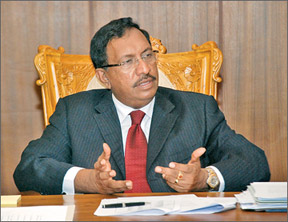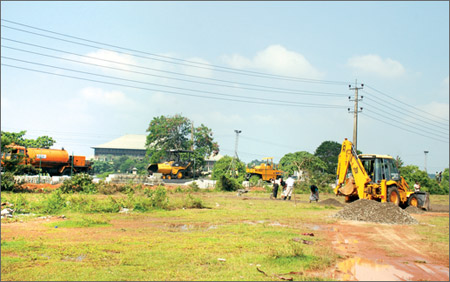|
Green Belt to mark Deyata Sevana anniversary:
Create a country covered with trees - Environment Minister
By Dhaneshi YATAWARA
|

Environment Minister Anura Priyadarshana Yapa |
A new green belt is to be created marking the anniversary of Deyata
Sevana the National Tree Planting program. Environment Minister Anura
Priyadarshana Yapa calls upon citizens to participate in the program by
planting a tree in their home gardens to create a Sri Lanka covered in
greenery. "Sri Lanka is in a good position, regarding sustainable
development which complies with environment security," said Minister
Yapa in a discussion with the media held recently at the ministry
premises. Following are excerpts of the discussion;
Q: How do you propose to hold the National Tree planting
program Deyata Sevana this year?
A: On the day the 2011 Deyata Sevana program commences we plan
to develop a green belt on the seven acre land adjoining the Japan
Friendship road near the Diyawanna Oya as instructed by President
Mahinda Rajapaksa . The Environment Ministry is carrying out the
construction work to convert the land into a green park. President
Rajapaksa will plant the first sapling at the auspicious time of 9.01 am
on November 15. This will begin the second phase of the Deyata Sevana
tree planting campaign. The Government sector assisted us to make this
campaign a success - specially the tri- forces and the Police and
different Government offices. The Sri Lanka Army Engineers assisted to
complete the project almost for only one fourth of the estimated cost.
We had to bear only the cost of the material. Urban Development
Authority, Land Reclamation and Development Corporation, and the
Kaduwela Municipal Council are major contributors. We intend to develop
this in to a park with the assistance of the Department of Botanical
Gardens and planning of the Land Reclamation and Development
Corporation. Last year 2,902,851 trees were planted in the country and
as of now 2,153,667 plants have survived. That is nearly 72% survived.
Q: Why did the Environment Ministry come up with the idea of a
tree planting campaign?
A: This is to inculcate a love for trees. There should be
encouragement from the community itself to protect trees and forests for
the future generation. Several private companies got involved in these
activities as their community service programs. Individual events of
creating a canopy cover in different parts of the country has fallen
into place, following the establishment of a solid base through Deyata
Sevana.
Q: What is Sri Lanka's target to increase tree cover in the
country?
|

The Green Belt to mark Deyata Sevana 2011 being cleared to plant
trees along a land area running by the Japan-Sri Lanka
Friendship Road.
|
A: Sri Lanka could be one of the countries growing a large
number of trees. Certain non governmental organisations are also joining
with us to increase the number of trees. Hilltop tree planting was
started last year. The project will start from Hunnasgiriya in the
central hills. Through the budget we will get financial support for this
project. In 2012 we plan to plant 425 ha of hill tops. In 2011 we have
planted 343 ha. According to the Mahinda Chinthana development policy we
plan to increase Sri Lanka's forest cover up to 35 percent.
Q: When tree planting is taking place on the one side is there
an increase in illegal timber felling on the other?
A: I don't disagree. Illegal timber felling is taking place.
We cannot rule this out. Certain groups are involved in the timber
racket. Even the Conservator General for forests is facing a lot of
problems. Whenever such cases are nabbed we take legal action.
We are trying our best to mitigate the issue through effectively
implementing the law. All activities need to be controlled. Two to three
months ago, we sent a team of officers to Bibile and there was a massive
racket of illegal timber felling in the Nilgala area.
A case has been filed against them the legal procedure is continuing.
There are certain Government officials also involved. We have to
ascertain that as well. We have informed the necessary government
institutes that they have to take proper action against such officers.
This is not a perfect job. With the small number of officials we are
doing with our best to protect the environment. When we nab racketeers,
we prosecute them. We are not idling. As far as the environment is
concerned, the situation is not bad.
Q: Do we need to strengthen the law?
A: Strengthening the law is not the main thing. My thinking is
we will have to have dialogue with the people. We need to interact more
with people living close to forests. Then they can detect timber
felling. If they really understand the value of forests then they will
not do it nor will they allow others to cut trees. We also will get
on-the-spot information. This strategy is on at the moment. And will be
expanded in the future. We also need to understand that there is a
timber requirement as well.
That is one of our responsibilities too. We are managing the
situation in a methodical way.
Q: The government recently transferred forest areas that were
under local authorities to the Department of Forest Conservation.
How do you protect environmentally sensitive areas which do not come
under the Ministry?
A: We cannot interfere with lands that do not belong to us.
Yet we can declare certain areas as environmentally sensitive areas. The
Central Environment Authority is doing this. Certain lands that come
under traditional law have been existing since the era or king's. These
we cannot change. We can under the national Environment law demarcate
environmentally sensitive areas after ascertaining certain criteria.
Q: What are we as a country doing to face the Climate change
challenge?
A: The draft for the policy is ready. Why we can't take a
concrete position is because the world is not ready with regard to
making changes to mitigate global warming. Today we are not considered
as a small island. We are not getting assistance from other countries
because we are now a middle income country. But if we ascertain the
effects of global warming such as sea level rising then our coastal area
is at risk. And if rain gets heavier there can be landslides. We have
developed a strategy and we are modifying that strategy now. We are
meeting all the stakeholders and preparing for COP17. Relevant officials
will be attending the seventeenth Conference of the Parties (COP17) to
the United Nations Framework Convention on Climate Change which will be
held in Durban in South Africa.
SAARC countries are supporting to mitigate the climate change but the
problem is we are in a very unique position. We are a fast developing
country with very low carbon emission. We have a development forecast
and that cannot be underestimated.
We need to ascertain how our future is going to be. We can be a
carbon neutral country but that doesn't affect the world. If the
developed countries are continuing to emit carbon atmosphere and the
temperature rises it will have a big impact on the global environment.
Our situation is not so alarming as many imagine it to be.
If we can get the technological transfer, bilaterally or
multilaterally, then we will be on a better footing. Many of our
business ventures are transferring to green energy. Even our traditional
export sector is changing. Yet technology is the biggest issue. Our
emphasis is to get green technology from countries who have excelled in
green energy techniques. That is what we are trying to do.
Q: Are the institutes under the ministry running at a loss?
A: The Timber Corporation is one of Sri Lanka's most
profitable government organisations. Our profit is Rs. 3.5 billion.
Annually we pay nearly Rs. 1 billion as taxes on profit. All
organisations under the Environment Ministry are making significant
profit. The Gem and Jewellery Authority has regained from the loss and
now making profit. We managed to rectify the Rs. 11 million loss this
year. I can assure that we will end up with very high profit. The
Geological and Mines Bureau pays Rs. 500 million yearly to the
Government. On certain years it has gone upto Rs. 750 million. The
Central Environment Authority does not depend on the treasury.
Q: How do you plan to mitigate the various environment
destructing activities taking place in the country?
A: We will not stop all the activities at once. People should
have time to divert from certain environment based industries like sand
mining. We will gradually phase out. We have to be mindful about the
nearly 22 million people living in this country.
Where there should be sustainable development to elevate living
standards. The environment needs to be protected while not hurting the
innocent hopes of people and their employment opportunities.
We have to have a humane angle in whatever step we take. If we
consider minimising river sand usage for construction work. The best
method would be to replace it with sea sand.
We have made the suggestion to the government and we need to find a
proper method to wash and clean sea sand to remove unwanted mineral
residue. There are various ways in many other countries through which we
can get an idea on how to implement a method to suit local needs. To
bring ground water level to its original status we need to stop digging
river basins for sand. Still we can not stop sand mining all at once
|

